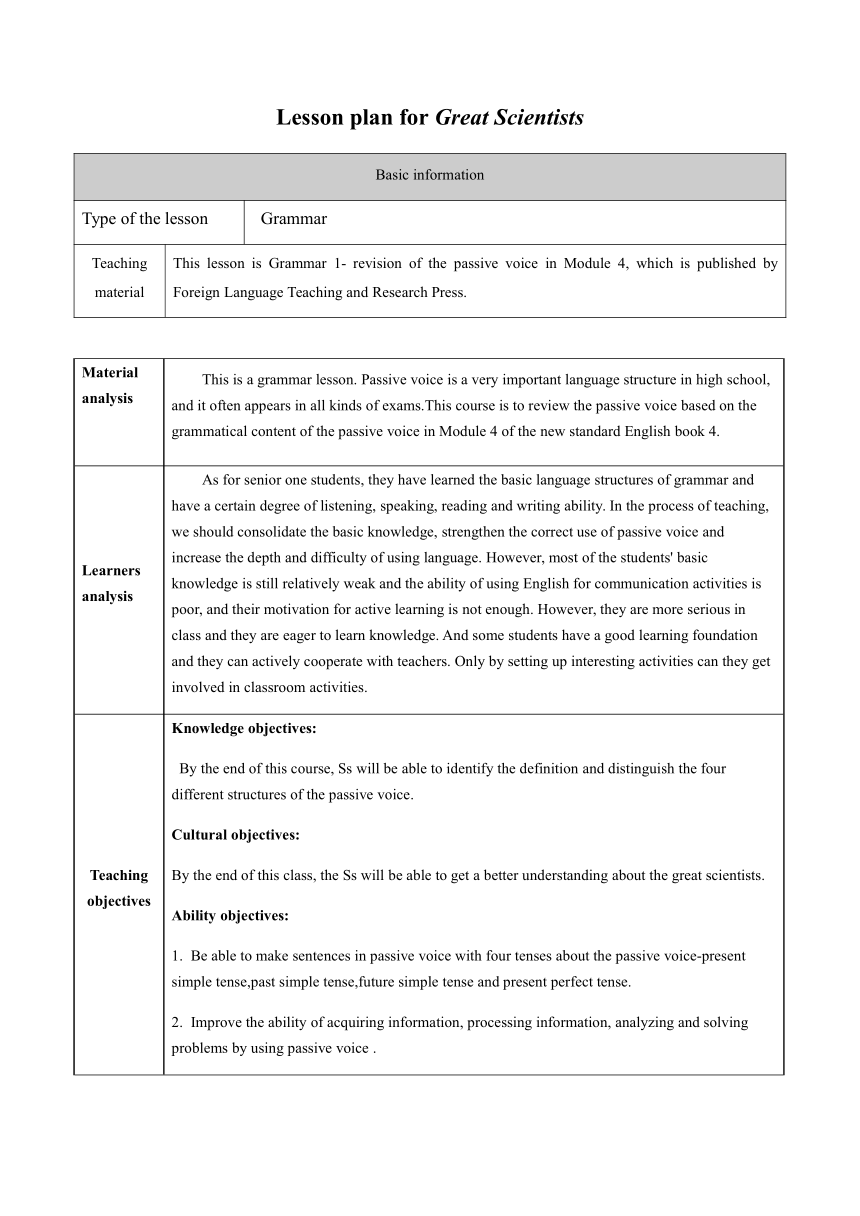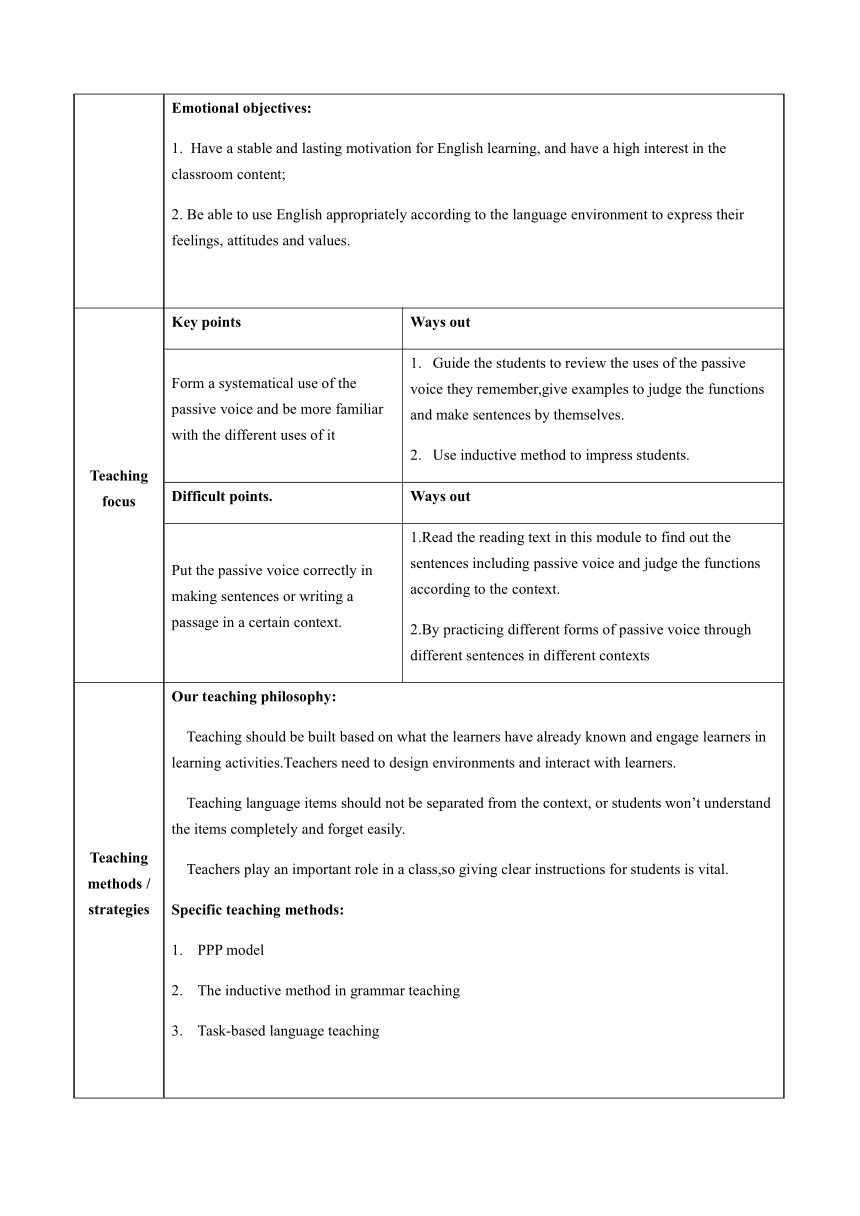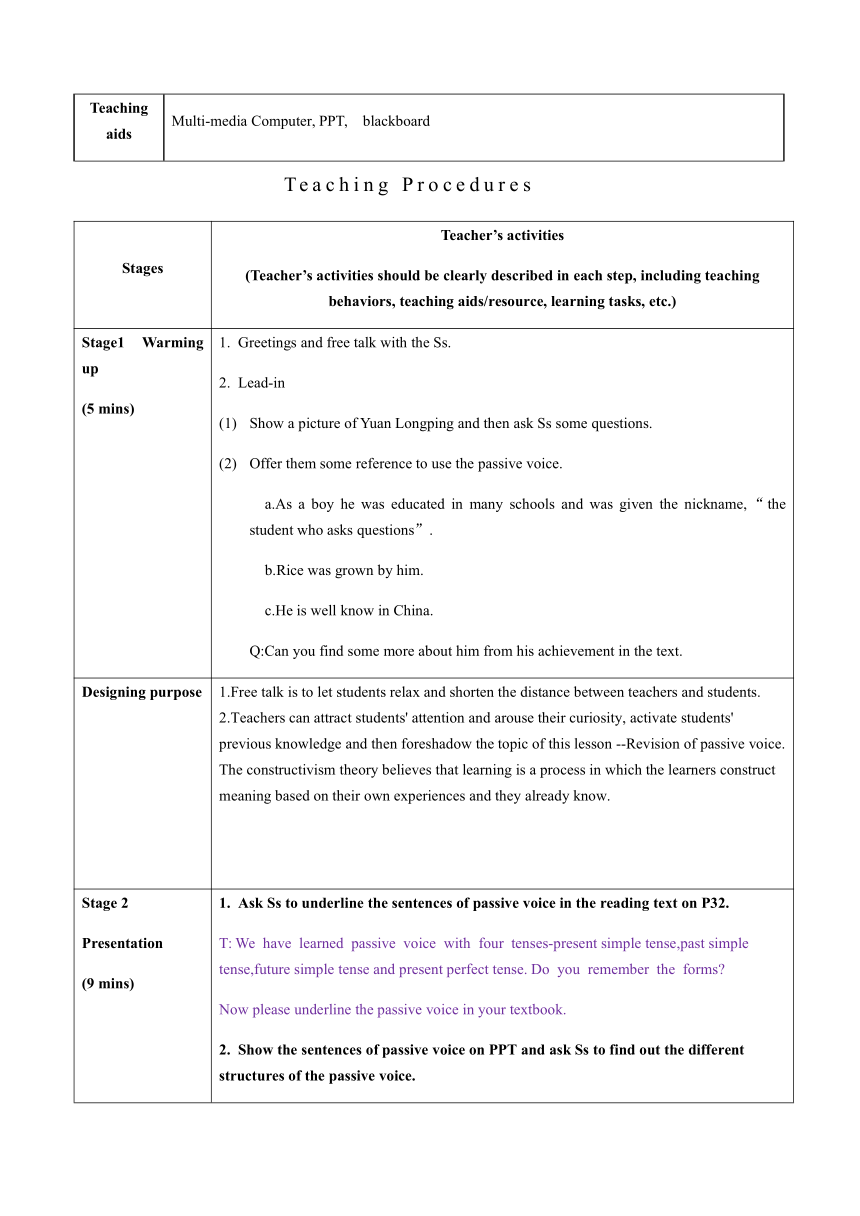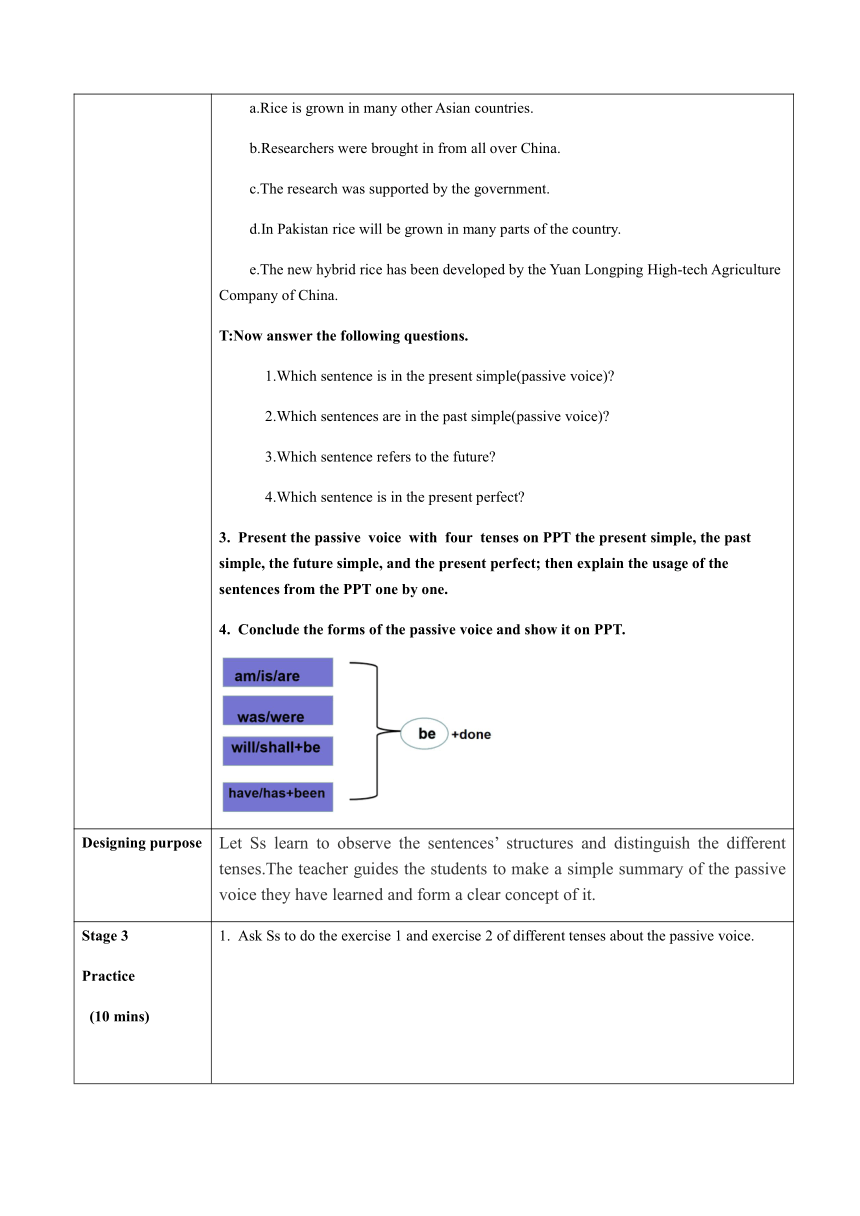外研版高一英语必修四unit4 Great Scientists语法课教案
文档属性
| 名称 | 外研版高一英语必修四unit4 Great Scientists语法课教案 |

|
|
| 格式 | zip | ||
| 文件大小 | 933.0KB | ||
| 资源类型 | 教案 | ||
| 版本资源 | 外研版 | ||
| 科目 | 英语 | ||
| 更新时间 | 2020-05-27 18:29:07 | ||
图片预览




文档简介
Lesson
plan
for
Great
Scientists
Basic
information
Type
of
the
lesson
Grammar
Teaching
material
This
lesson
is
Grammar
1-
revision
of
the
passive
voice
in
Module
4,
which
is
published
by
Foreign
Language
Teaching
and
Research
Press.
Material
analysis
This
is
a
grammar
lesson.
Passive
voice
is
a
very
important
language
structure
in
high
school,
and
it
often
appears
in
all
kinds
of
exams.This
course
is
to
review
the
passive
voice
based
on
the
grammatical
content
of
the
passive
voice
in
Module
4
of
the
new
standard
English
book
4.
Learners
analysis
As
for
senior
one
students,
they
have
learned
the
basic
language
structures
of
grammar
and
have
a
certain
degree
of
listening,
speaking,
reading
and
writing
ability.
In
the
process
of
teaching,
we
should
consolidate
the
basic
knowledge,
strengthen
the
correct
use
of
passive
voice
and
increase
the
depth
and
difficulty
of
using
language.
However,
most
of
the
students'
basic
knowledge
is
still
relatively
weak
and
the
ability
of
using
English
for
communication
activities
is
poor,
and
their
motivation
for
active
learning
is
not
enough.
However,
they
are
more
serious
in
class
and
they
are
eager
to
learn
knowledge.
And
some
students
have
a
good
learning
foundation
and
they
can
actively
cooperate
with
teachers.
Only
by
setting
up
interesting
activities
can
they
get
involved
in
classroom
activities.
Teaching
objectives
Knowledge
objectives:
By
the
end
of
this
course,
Ss
will
be
able
to
identify
the
definition
and
distinguish
the
four
different
structures
of
the
passive
voice.
Cultural
objectives:By
the
end
of
this
class,
the
Ss
will
be
able
to
get
a
better
understanding
about
the
great
scientists.Ability
objectives:
Be
able
to
make
sentences
in
passive
voice
with
four
tenses
about
the
passive
voice-present
simple
tense,past
simple
tense,future
simple
tense
and
present
perfect
tense.Improve
the
ability
of
acquiring
information,
processing
information,
analyzing
and
solving
problems
by
using
passive
voice
.Emotional
objectives:
Have
a
stable
and
lasting
motivation
for
English
learning,
and
have
a
high
interest
in
the
classroom
content;
?2.
Be
able
to
use
English
appropriately
according
to
the
language
environment
to
express
their
feelings,
attitudes
and
values.
Teaching
focus
Key
points
Ways
out
Form
a
systematical
use
of
the
passive
voice
and
be
more
familiar
with
the
different
uses
of
it
Guide
the
students
to
review
the
uses
of
the
passive
voice
they
remember,give
examples
to
judge
the
functions
and
make
sentences
by
themselves.Use
inductive
method
to
impress
students.
Difficult
points.
Ways
out
Put
the
passive
voice
correctly
in
making
sentences
or
writing
a
passage
in
a
certain
context.
1.Read
the
reading
text
in
this
module
to
find
out
the
sentences
including
passive
voice
and
judge
the
functions
according
to
the
context.2.By
practicing
different
forms
of
passive
voice
through
different
sentences
in
different
contexts
Teaching
methods
/
strategies
Our
teaching
philosophy:
Teaching
should
be
built
based
on
what
the
learners
have
already
known
and
engage
learners
in
learning
activities.Teachers
need
to
design
environments
and
interact
with
learners.
Teaching
language
items
should
not
be
separated
from
the
context,
or
students
won’t
understand
the
items
completely
and
forget
easily.
Teachers
play
an
important
role
in
a
class,so
giving
clear
instructions
for
students
is
vital.Specific
teaching
methods:PPP
modelThe
inductive
method
in
grammar
teachingTask-based
language
teaching
Teaching
aids
Multi-media
Computer,
PPT,
blackboard
Teaching
Procedures
Stages
Teacher’s
activities(Teacher’s
activities
should
be
clearly
described
in
each
step,
including
teaching
behaviors,
teaching
aids/resource,
learning
tasks,
etc.)
Stage1
Warming
up
(5
mins)
Greetings
and
free
talk
with
the
Ss.Lead-inShow
a
picture
of
Yuan
Longping
and
then
ask
Ss
some
questions.
Offer
them
some
reference
to
use
the
passive
voice.
a.As
a
boy
he
was
educated
in
many
schools
and
was
given
the
nickname,“the
student
who
asks
questions”.
b.Rice
was
grown
by
him.
c.He
is
well
know
in
China.
Q:Can
you
find
some
more
about
him
from
his
achievement
in
the
text.
Designing
purpose
1.Free
talk
is
to
let
students
relax
and
shorten
the
distance
between
teachers
and
students.2.Teachers
can
attract
students'
attention
and
arouse
their
curiosity,
activate
students'
previous
knowledge
and
then
foreshadow
the
topic
of
this
lesson
--Revision
of
passive
voice.
The
constructivism
theory
believes
that
learning
is
a
process
in
which
the
learners
construct
meaning
based
on
their
own
experiences
and
they
already
know.
Stage
2Presentation
(9
mins)
Ask
Ss
to
underline
the
sentences
of
passive
voice
in
the
reading
text
on
P32.T:
We?have?learned?passive?voice?with?four?tenses-present
simple
tense,past
simple
tense,future
simple
tense
and
present
perfect
tense.
Do?you?remember?the?forms?Now
please
underline
the
passive
voice
in
your
textbook.Show
the
sentences
of
passive
voice
on
PPT
and
ask
Ss
to
find
out
the
different
structures
of
the
passive
voice.a.Rice
is
grown
in
many
other
Asian
countries.b.Researchers
were
brought
in
from
all
over
China.c.The
research
was
supported
by
the
government.d.In
Pakistan
rice
will
be
grown
in
many
parts
of
the
country.e.The
new
hybrid
rice
has
been
developed
by
the
Yuan
Longping
High-tech
Agriculture
Company
of
China.T:Now
answer
the
following
questions.1.Which
sentence
is
in
the
present
simple(passive
voice)?2.Which
sentences
are
in
the
past
simple(passive
voice)?3.Which
sentence
refers
to
the
future?4.Which
sentence
is
in
the
present
perfect?Present
the
passive?voice?with?four?tenses
on
PPT
the
present
simple,
the
past
simple,
the
future
simple,
and
the
present
perfect;
then
explain
the
usage
of
the
sentences
from
the
PPT
one
by
one.Conclude
the
forms
of
the
passive
voice
and
show
it
on
PPT.
Designing
purpose
Let
Ss
learn
to
observe
the
sentences’
structures
and
distinguish
the
different
tenses.The
teacher
guides
the
students
to
make
a
simple
summary
of
the
passive
voice
they
have
learned
and
form
a
clear
concept
of
it.
Stage
3Practice
(10
mins)
Ask
Ss
to
do
the
exercise
1
and
exercise
2
of
different
tenses
about
the
passive
voice.Exercise
2Fill
in
the
blanks.Part
oneLihui:
Let's
learn
other
scientists.Lihua:
Cailun
is
a
great
inventor
I'd
like
to
talk.Lihui:
Great,we
all
know
that
Papermaking
___________(invent)
by
him.Lihua:Yes,with
the
development
of
society,
different
types
of
paper
_______(develope)
so
far.Lihui:Maybe
in
the
future,
new
paper
_________(create)
and
_____
(use)
in
other
area.Part
2Tom:Do
you
know
some
famous
scientists?
Tina:Yes,Stephen
Hawking,he
________
(know)
at
home
and
abroad
widely.Tom:for
example?Tina:He
_______(graduate)
from
Oxford
University.In
the
1960s,He________
(diagnose)with
motor
neurone
disease.but
he
never
gave
up,
his
book
A
Brief
History
of
Time________
(publish)in
1988.He
is
so
outstanding
and
we
_______(
influence)
by
him.Tom:Right.we
all
believe
his
work_________
(use)
in
other
new
field
that
_______(explore)
by
others
scientists
recently.
Designing
purpose
The
exercises
are
designed
at
different
levels
which
are
from
easy
to
difficult
in
various
forms
when
considering
the
students’
cognitive.This
step
is
to
give
students
chances
to
practise
the
language
point—the
passive
voice,
and
guide
students
to
consolidate
and
develop
knowledge.
Stage4
Production
(11
mins
)
Discussion
and
making
sentences
in
groups.1.Teacher
show
some
pictures
in
the
PPT,
then
ask
Ss
to
discuss
and
describe
the
picture
by
using
the
correct
form
of
passive
voice
in
groups.
And
some
prompts
are
given
besides
the
picture.T:
I?think?you?have?learned?passive?voice?by?hearts.
Now,
we?will?make?some?sentences?in?passive?voice
in
passive
voice.You
know,we
should
learn
not
only
their
forms
but
also
how
to
use
them
correctly.
Ask
Ss
to
discuss
the
exercise
in
groups
and
finish
it.Practice
1:
Make
sentences
according
to
the
pictures
and
given
words.Write
a
short
dialogue
within
sive
sentences
to
describe
the
scientists
with
the
right
types
of
PV.
Scientists
are
as
follows:MadameCurie,Edison
ect.Give
some
comments
on
the
Ss’
performance
and
then
give
a
brief
conclusion.
Designing
purpose
Train
their
team
spirit
and
guide
them
to
combine
the
knowledge
with
different
contexts
in
order
to
use
the
passive
voice
correctly
to
make
sentences.According
to
Chomsky,
a
language
learner
acquire
language
competence
which
enable
him
to
produce
language.So
the
arrangement
is
to
reinforce
the
knowledge
they
have
learned
from
this
class.
Stage
5Summary
and
homework(5
mins)
Summarize
the
knowledge
we’ve
learned
today,
make
a
comment
on
their
performance
during
this
class
and
point
out
what
they
need
to
improve.2.
Assign
the
homework
for
Ss.a.Ask
Ss
to
complete
the
exercises
in
the
workbook
on
P85.b.Use
passive
voice
to
write
a
passage
at
least
80
words
by
giving
some
hints.
Designing
purpose
Deepen
their
impression
on
what
they
have
learned
today.Homework
is
an
good
way
to
check
the
efficiency
of
the
teaching
content
of
this
lesson.
And
arranging
homework
at
different
levels
is
to
meet
the
needs
of
students
at
all
levels.Homework
after
class
is
the
consolidation,
extension
and
expansion
of
teaching
content.
The
homework
assigned
reflect
the
overall
content
of
this
lesson
and
guide
students'
further
learning.
Teaching
reflection(教学预测/课后反思):Highlights
and
limitations
of
this
lesson:
Firstly,
this
lesson
is
a
task-based
process
in
which
the
teacher
manages
to
set
up
scaffolding
for
the
students
by
carried
out
a
series
of
closely-connected
and
difficulty-increased
tasks.Secondly,
in
this
class
,the
teacher
tries
to
improve
the
Ss’
overall
ability,including
the
language
skills,language
knowledge,
emotional
attitude
and
learning
strategies.However,
the
activities
are
not
very
interesting,
so
the
students
may
not
be
very
enthusiastic
in
this
class.
And
the
design
of
this
lesson
may
not
be
so
effective
in
developing
the
Ss’
critical
thinking.
Blackboard/PPT
Design(板书/媒体设计)
Module
4
The
Passive
VoiceBe+done1.the
present
simple:
am/is/are+done2.the
past
simple:
was/were+done3.the
future
simple:
will
be+done4.the
present
perfect:
have/has+been+done
plan
for
Great
Scientists
Basic
information
Type
of
the
lesson
Grammar
Teaching
material
This
lesson
is
Grammar
1-
revision
of
the
passive
voice
in
Module
4,
which
is
published
by
Foreign
Language
Teaching
and
Research
Press.
Material
analysis
This
is
a
grammar
lesson.
Passive
voice
is
a
very
important
language
structure
in
high
school,
and
it
often
appears
in
all
kinds
of
exams.This
course
is
to
review
the
passive
voice
based
on
the
grammatical
content
of
the
passive
voice
in
Module
4
of
the
new
standard
English
book
4.
Learners
analysis
As
for
senior
one
students,
they
have
learned
the
basic
language
structures
of
grammar
and
have
a
certain
degree
of
listening,
speaking,
reading
and
writing
ability.
In
the
process
of
teaching,
we
should
consolidate
the
basic
knowledge,
strengthen
the
correct
use
of
passive
voice
and
increase
the
depth
and
difficulty
of
using
language.
However,
most
of
the
students'
basic
knowledge
is
still
relatively
weak
and
the
ability
of
using
English
for
communication
activities
is
poor,
and
their
motivation
for
active
learning
is
not
enough.
However,
they
are
more
serious
in
class
and
they
are
eager
to
learn
knowledge.
And
some
students
have
a
good
learning
foundation
and
they
can
actively
cooperate
with
teachers.
Only
by
setting
up
interesting
activities
can
they
get
involved
in
classroom
activities.
Teaching
objectives
Knowledge
objectives:
By
the
end
of
this
course,
Ss
will
be
able
to
identify
the
definition
and
distinguish
the
four
different
structures
of
the
passive
voice.
Cultural
objectives:By
the
end
of
this
class,
the
Ss
will
be
able
to
get
a
better
understanding
about
the
great
scientists.Ability
objectives:
Be
able
to
make
sentences
in
passive
voice
with
four
tenses
about
the
passive
voice-present
simple
tense,past
simple
tense,future
simple
tense
and
present
perfect
tense.Improve
the
ability
of
acquiring
information,
processing
information,
analyzing
and
solving
problems
by
using
passive
voice
.Emotional
objectives:
Have
a
stable
and
lasting
motivation
for
English
learning,
and
have
a
high
interest
in
the
classroom
content;
?2.
Be
able
to
use
English
appropriately
according
to
the
language
environment
to
express
their
feelings,
attitudes
and
values.
Teaching
focus
Key
points
Ways
out
Form
a
systematical
use
of
the
passive
voice
and
be
more
familiar
with
the
different
uses
of
it
Guide
the
students
to
review
the
uses
of
the
passive
voice
they
remember,give
examples
to
judge
the
functions
and
make
sentences
by
themselves.Use
inductive
method
to
impress
students.
Difficult
points.
Ways
out
Put
the
passive
voice
correctly
in
making
sentences
or
writing
a
passage
in
a
certain
context.
1.Read
the
reading
text
in
this
module
to
find
out
the
sentences
including
passive
voice
and
judge
the
functions
according
to
the
context.2.By
practicing
different
forms
of
passive
voice
through
different
sentences
in
different
contexts
Teaching
methods
/
strategies
Our
teaching
philosophy:
Teaching
should
be
built
based
on
what
the
learners
have
already
known
and
engage
learners
in
learning
activities.Teachers
need
to
design
environments
and
interact
with
learners.
Teaching
language
items
should
not
be
separated
from
the
context,
or
students
won’t
understand
the
items
completely
and
forget
easily.
Teachers
play
an
important
role
in
a
class,so
giving
clear
instructions
for
students
is
vital.Specific
teaching
methods:PPP
modelThe
inductive
method
in
grammar
teachingTask-based
language
teaching
Teaching
aids
Multi-media
Computer,
PPT,
blackboard
Teaching
Procedures
Stages
Teacher’s
activities(Teacher’s
activities
should
be
clearly
described
in
each
step,
including
teaching
behaviors,
teaching
aids/resource,
learning
tasks,
etc.)
Stage1
Warming
up
(5
mins)
Greetings
and
free
talk
with
the
Ss.Lead-inShow
a
picture
of
Yuan
Longping
and
then
ask
Ss
some
questions.
Offer
them
some
reference
to
use
the
passive
voice.
a.As
a
boy
he
was
educated
in
many
schools
and
was
given
the
nickname,“the
student
who
asks
questions”.
b.Rice
was
grown
by
him.
c.He
is
well
know
in
China.
Q:Can
you
find
some
more
about
him
from
his
achievement
in
the
text.
Designing
purpose
1.Free
talk
is
to
let
students
relax
and
shorten
the
distance
between
teachers
and
students.2.Teachers
can
attract
students'
attention
and
arouse
their
curiosity,
activate
students'
previous
knowledge
and
then
foreshadow
the
topic
of
this
lesson
--Revision
of
passive
voice.
The
constructivism
theory
believes
that
learning
is
a
process
in
which
the
learners
construct
meaning
based
on
their
own
experiences
and
they
already
know.
Stage
2Presentation
(9
mins)
Ask
Ss
to
underline
the
sentences
of
passive
voice
in
the
reading
text
on
P32.T:
We?have?learned?passive?voice?with?four?tenses-present
simple
tense,past
simple
tense,future
simple
tense
and
present
perfect
tense.
Do?you?remember?the?forms?Now
please
underline
the
passive
voice
in
your
textbook.Show
the
sentences
of
passive
voice
on
PPT
and
ask
Ss
to
find
out
the
different
structures
of
the
passive
voice.a.Rice
is
grown
in
many
other
Asian
countries.b.Researchers
were
brought
in
from
all
over
China.c.The
research
was
supported
by
the
government.d.In
Pakistan
rice
will
be
grown
in
many
parts
of
the
country.e.The
new
hybrid
rice
has
been
developed
by
the
Yuan
Longping
High-tech
Agriculture
Company
of
China.T:Now
answer
the
following
questions.1.Which
sentence
is
in
the
present
simple(passive
voice)?2.Which
sentences
are
in
the
past
simple(passive
voice)?3.Which
sentence
refers
to
the
future?4.Which
sentence
is
in
the
present
perfect?Present
the
passive?voice?with?four?tenses
on
PPT
the
present
simple,
the
past
simple,
the
future
simple,
and
the
present
perfect;
then
explain
the
usage
of
the
sentences
from
the
PPT
one
by
one.Conclude
the
forms
of
the
passive
voice
and
show
it
on
PPT.
Designing
purpose
Let
Ss
learn
to
observe
the
sentences’
structures
and
distinguish
the
different
tenses.The
teacher
guides
the
students
to
make
a
simple
summary
of
the
passive
voice
they
have
learned
and
form
a
clear
concept
of
it.
Stage
3Practice
(10
mins)
Ask
Ss
to
do
the
exercise
1
and
exercise
2
of
different
tenses
about
the
passive
voice.Exercise
2Fill
in
the
blanks.Part
oneLihui:
Let's
learn
other
scientists.Lihua:
Cailun
is
a
great
inventor
I'd
like
to
talk.Lihui:
Great,we
all
know
that
Papermaking
___________(invent)
by
him.Lihua:Yes,with
the
development
of
society,
different
types
of
paper
_______(develope)
so
far.Lihui:Maybe
in
the
future,
new
paper
_________(create)
and
_____
(use)
in
other
area.Part
2Tom:Do
you
know
some
famous
scientists?
Tina:Yes,Stephen
Hawking,he
________
(know)
at
home
and
abroad
widely.Tom:for
example?Tina:He
_______(graduate)
from
Oxford
University.In
the
1960s,He________
(diagnose)with
motor
neurone
disease.but
he
never
gave
up,
his
book
A
Brief
History
of
Time________
(publish)in
1988.He
is
so
outstanding
and
we
_______(
influence)
by
him.Tom:Right.we
all
believe
his
work_________
(use)
in
other
new
field
that
_______(explore)
by
others
scientists
recently.
Designing
purpose
The
exercises
are
designed
at
different
levels
which
are
from
easy
to
difficult
in
various
forms
when
considering
the
students’
cognitive.This
step
is
to
give
students
chances
to
practise
the
language
point—the
passive
voice,
and
guide
students
to
consolidate
and
develop
knowledge.
Stage4
Production
(11
mins
)
Discussion
and
making
sentences
in
groups.1.Teacher
show
some
pictures
in
the
PPT,
then
ask
Ss
to
discuss
and
describe
the
picture
by
using
the
correct
form
of
passive
voice
in
groups.
And
some
prompts
are
given
besides
the
picture.T:
I?think?you?have?learned?passive?voice?by?hearts.
Now,
we?will?make?some?sentences?in?passive?voice
in
passive
voice.You
know,we
should
learn
not
only
their
forms
but
also
how
to
use
them
correctly.
Ask
Ss
to
discuss
the
exercise
in
groups
and
finish
it.Practice
1:
Make
sentences
according
to
the
pictures
and
given
words.Write
a
short
dialogue
within
sive
sentences
to
describe
the
scientists
with
the
right
types
of
PV.
Scientists
are
as
follows:MadameCurie,Edison
ect.Give
some
comments
on
the
Ss’
performance
and
then
give
a
brief
conclusion.
Designing
purpose
Train
their
team
spirit
and
guide
them
to
combine
the
knowledge
with
different
contexts
in
order
to
use
the
passive
voice
correctly
to
make
sentences.According
to
Chomsky,
a
language
learner
acquire
language
competence
which
enable
him
to
produce
language.So
the
arrangement
is
to
reinforce
the
knowledge
they
have
learned
from
this
class.
Stage
5Summary
and
homework(5
mins)
Summarize
the
knowledge
we’ve
learned
today,
make
a
comment
on
their
performance
during
this
class
and
point
out
what
they
need
to
improve.2.
Assign
the
homework
for
Ss.a.Ask
Ss
to
complete
the
exercises
in
the
workbook
on
P85.b.Use
passive
voice
to
write
a
passage
at
least
80
words
by
giving
some
hints.
Designing
purpose
Deepen
their
impression
on
what
they
have
learned
today.Homework
is
an
good
way
to
check
the
efficiency
of
the
teaching
content
of
this
lesson.
And
arranging
homework
at
different
levels
is
to
meet
the
needs
of
students
at
all
levels.Homework
after
class
is
the
consolidation,
extension
and
expansion
of
teaching
content.
The
homework
assigned
reflect
the
overall
content
of
this
lesson
and
guide
students'
further
learning.
Teaching
reflection(教学预测/课后反思):Highlights
and
limitations
of
this
lesson:
Firstly,
this
lesson
is
a
task-based
process
in
which
the
teacher
manages
to
set
up
scaffolding
for
the
students
by
carried
out
a
series
of
closely-connected
and
difficulty-increased
tasks.Secondly,
in
this
class
,the
teacher
tries
to
improve
the
Ss’
overall
ability,including
the
language
skills,language
knowledge,
emotional
attitude
and
learning
strategies.However,
the
activities
are
not
very
interesting,
so
the
students
may
not
be
very
enthusiastic
in
this
class.
And
the
design
of
this
lesson
may
not
be
so
effective
in
developing
the
Ss’
critical
thinking.
Blackboard/PPT
Design(板书/媒体设计)
Module
4
The
Passive
VoiceBe+done1.the
present
simple:
am/is/are+done2.the
past
simple:
was/were+done3.the
future
simple:
will
be+done4.the
present
perfect:
have/has+been+done
